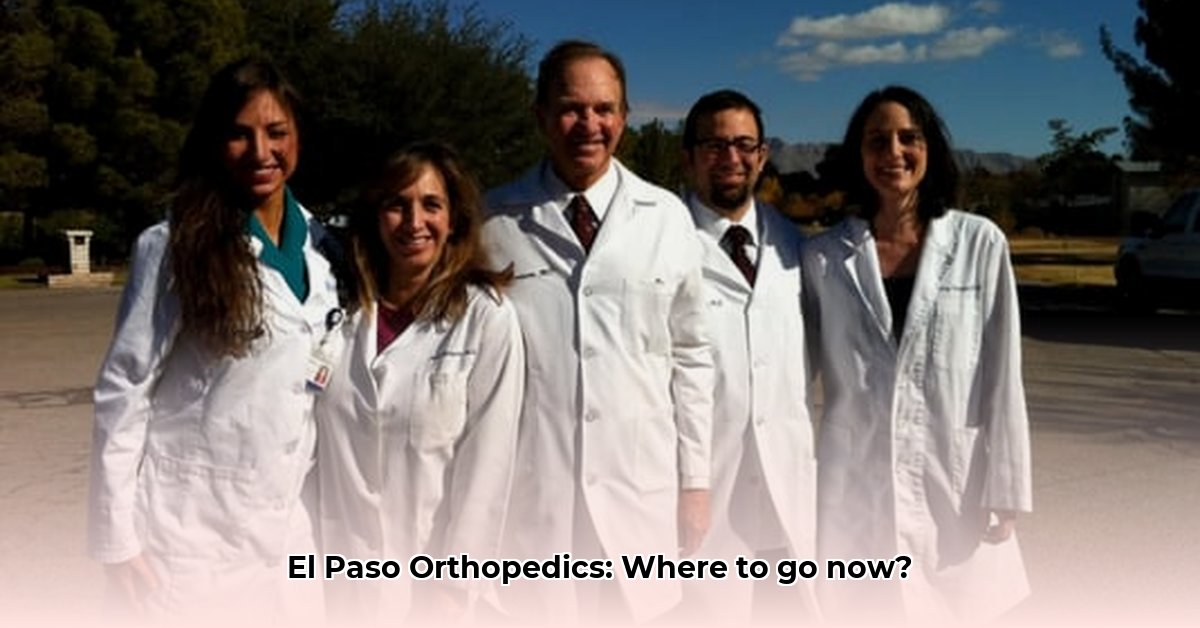
The recent closure of El Paso Orthopaedic Surgery Group (EPSOG) has understandably raised concerns about access to orthopedic care in the region. While the precise reasons for the closure remain undisclosed, the impact on El Paso residents seeking treatment for bone and joint issues is significant. This analysis explores the consequences of EPSOG's closure and outlines actionable steps for patients seeking continued, high-quality care.
Understanding the Impact of EPSOG's Closure
EPSOG served a substantial portion of El Paso's orthopedic care needs, offering a comprehensive range of services from diagnosis to complex surgeries like joint replacements. Their closure has created a ripple effect, increasing the demand on remaining orthopedic practices. This increased demand may lead to longer wait times for appointments and potential challenges in accessing specialized procedures. The sudden shift also underscores the importance of proactive planning and informed decision-making for patients needing orthopedic care. How will this increased demand impact patient access to timely and effective treatment options?
Finding Your New Orthopedic Doctor: A Step-by-Step Guide
Navigating the search for a new orthopedic doctor can be daunting, but a systematic approach can alleviate stress. The following steps provide a clear path:
Step 1: Assess Your Needs.
Begin by clarifying your specific orthopedic needs. Are you dealing with an acute injury (e.g., fracture, sprain) or a chronic condition (e.g., arthritis, degenerative disc disease)? Are you seeking preventative care or surgical intervention? Defining your needs will help you identify the appropriate specialist (e.g., sports medicine specialist, spine surgeon, joint replacement surgeon).
Step 2: Research El Paso Orthopedic Practices.
Numerous reputable orthopedic practices operate within El Paso. Utilize online search engines (e.g., Google, Bing), physician finders (e.g., WebMD, Healthgrades), and hospital websites to compile a list of potential providers. Look for details on providers’ specialties, experience, and patient reviews. A thorough investigation is crucial given the increased demand on remaining practices. What percentage of El Paso's orthopedic patient population did EPSOG previously serve? This data, if available, could help quantify the current increase in demand.
Step 3: Schedule Consultations.
Don't settle for the first provider you find. Scheduling consultations with several practices is strongly recommended. This allows you to compare their approaches, assess their communication style, and ensure a comfortable patient-physician relationship, crucial for effective treatment. How many consultations should a patient ideally schedule before making a decision? While subjective, consulting multiple providers might enhance the decision-making process.
Step 4: Consider Practical Factors.
Practical considerations such as location, office hours, parking availability, and insurance coverage should be factored into your decision. Ensuring accessibility and affordability is critical, particularly given the heightened demand post-EPSOG closure.
Step 5: Trust Your Instincts.
After meeting with several doctors, trust your gut feeling. Did the doctor listen attentively? Did they clearly explain your condition and treatment options? A positive and trusting physician-patient relationship is vital for successful healthcare outcomes.
Potential Challenges and Mitigation Strategies
The increased demand for orthopedic services following EPSOG's closure presents potential challenges. Longer wait times for appointments and potential difficulties in accessing specialized procedures are likely consequences. To mitigate these issues several strategies are necessary:
- Expanded Practice Capacity: Existing practices may need to expand their staff and resources to accommodate the increased patient volume.
- Recruitment of New Specialists: Efforts to recruit new orthopedic surgeons to the El Paso area are crucial.
- Telehealth Integration: Expanding telehealth capabilities could improve access to specialists for patients in remote areas and reduce the burden on in-person practices.
- Enhanced Care Coordination: Streamlining referral processes and collaboration among healthcare providers can enhance efficiency and access to care.
- Investment in Technology: Utilizing advanced diagnostic and treatment technologies can improve efficiency and patient outcomes.
The Future of Orthopedic Care in El Paso: Collaboration and Innovation
The closure of EPSOG serves as a catalyst for positive change in El Paso's orthopedic care system. A collaborative effort among healthcare providers, policymakers, and the community is essential. This includes:
- Attracting and retaining talented orthopedic specialists: Competitive compensation and desirable work environments are key.
- Expanding access to care through innovative models: Exploring alternative care delivery models, such as shared clinics and specialized centers, could improve access.
- Strategic investment in technology: Enhancing telehealth infrastructure and adopting new technologies can dramatically improve both access and quality of care.
- Streamlining administrative processes: Reducing administrative burdens can improve efficiency and allow providers to focus on patient care.
The closure of EPSOG presents a challenge, but it also presents an opportunity for significant improvement. By working together, El Paso can build a more robust and patient-centric orthopedic care system.